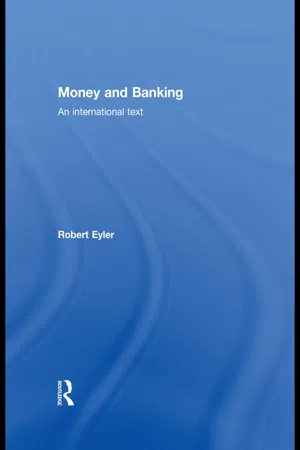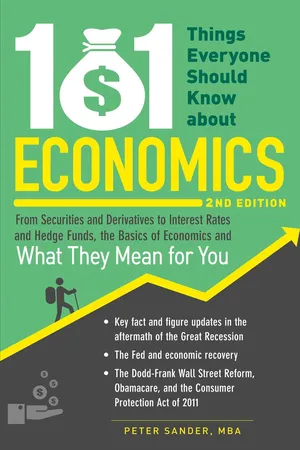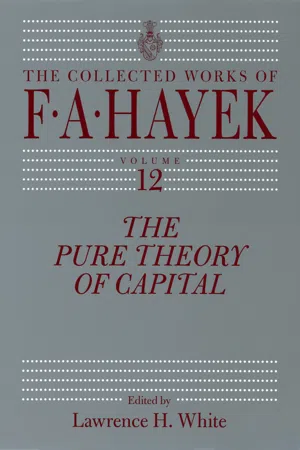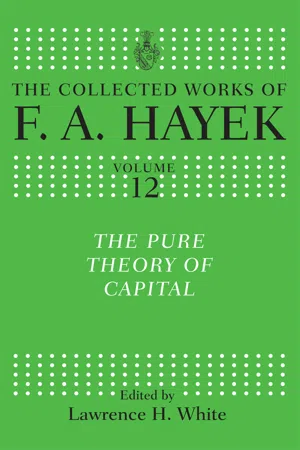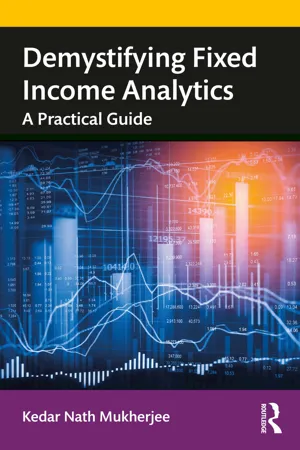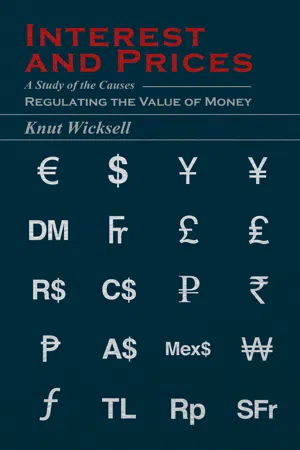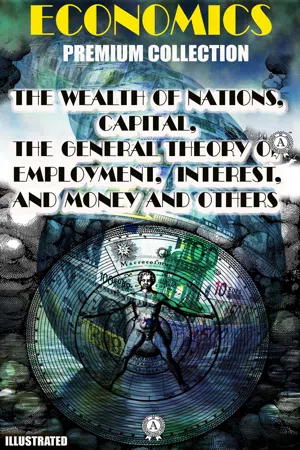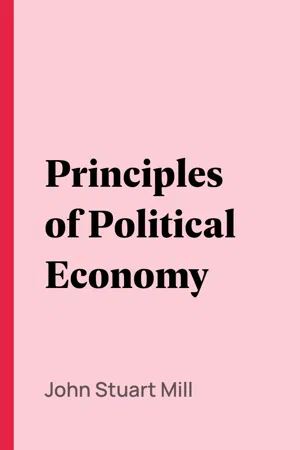Economics
Interest Rate Meaning
An interest rate is the cost of borrowing money or the return on investment, expressed as a percentage. It is a key tool used by central banks to regulate the economy, influencing borrowing, saving, and spending. Changes in interest rates can impact inflation, employment, and overall economic growth.
Written by Perlego with AI-assistance
Related key terms
10 Key excerpts on "Interest Rate Meaning"
- eBook - ePub
Money and Banking
An International Text
- Robert Eyler(Author)
- 2009(Publication Date)
- Routledge(Publisher)
Something we will explore in depth when we talk about money demand later is the idea of the interest rate as the opportunity cost of having cash in your pocket. This relationship between the quantity of cash or liquidity demanded and the interest rate is of key importance to a great deal of macroeconomic theories but also to monetary and fiscal policy in practice. The way consumers react to changes in interest rates paid on their cash holdings changes the demand for goods and services, as well as the demand for lending. However, for now the idea is simple: the interest rate is the opportunity cost of holding money in your wallet rather than in an interest-bearing account or investment.Measure of time preference
It is this definition that links the three above and binds them in the household’s eyes. When you chose to consume more than your income, or consume with credit rather than paying in full, you are making a choice about your time preference to consume. The interest rate is a measure of how people prefer to consume with respect to time: if the interest rate falls, there will be marginal changes in consumption based on a smaller cost of credit. Certain households which initially would save, say $1000, now spend $100 of that $1000 and save only $900. They still save a certain amount, but it is less. The lower interest rate has triggered an incentive for them to spend on credit, or prefer to spend now than later in time.The cost of borrowing falls in the previous example, providing an incentive to borrow. Certain lenders must provide the loan, thus they see the interest rate as the revenue from lending, and want to take advantage of it. Finally, the borrower must demand cash in order to spend, thus the cost of holding money must also be going down at the same time, and intuitively it does. The interest rate is all four of these ideas simultaneously, and must be for financial markets to work correctly. We will see later that the interest rate’s measure of time preference characteristic makes the entire economy work correctly. - eBook - ePub
101 Things Everyone Should Know About Economics
From Securities and Derivatives to Interest Rates and Hedge Funds, the Basics of Economics and What They Mean for You
- Peter Sander(Author)
- 2013(Publication Date)
- Adams Media(Publisher)
The good news: the sort of stagflation caused by regulation or economic inefficiencies is less likely to happen in the United States than elsewhere. Despite what it may seem like sometimes, the U.S. economy is considered to have one of the easiest and most consistent regulatory climates of any developed country. This is why many economists are concerned when they hear cries for more regulation, and why they became concerned with some of the proposed policy changes that came with the recent economic crisis—they want to preserve the “stable state” the United States offers for capitalist commerce.21. INTEREST RATES
An interest rate is the price a borrower pays to borrow money. The key word is price —for whatever reason, possibly owing to the negative references to the borrowing and lending of money in the Bible, the concept that interest is a price paid for the use of something, in this case, money, is poorly understood by most. If you think of interest rates as a price, sometimes too high, sometimes a bargain, you’ll learn to make better decisions when evaluating a borrowing opportunity.From your point of view, interest rates are a price, or cost, of using money. They are also the price, or benefit received, for letting someone else use your money, as in when you deposit money in a bank or buy a bond. Finally, on a national scale, interest rates are also a vital tool used by governments to control money supply and the availability of credit, and thus to exert some control over the economy.What You Should Know
Interest rates are normally expressed as a percentage of a borrowed balance over the period of one year. Many interest rates are quoted as a nominal, or ongoing, interest rate, with an “annualized percentage rate” quoted in parallel to account for all borrowing costs, including fees, associated with a borrowing transaction, on an annual basis. Federal law requires publication of APRs to allow simple “apples-to-apples” comparisons of the price to borrow money.The interest rate, or price, for the use of borrowed funds depends on several factors:- Length of loan term. How long will you keep the money you borrow? That will influence the price, because of two things. First is the opportunity foregone by the owner of the money to spend it or invest it in something else. People tend to prefer liquidity
- eBook - ePub
- F. A. Hayek, Lawrence H. White(Authors)
- 2011(Publication Date)
- University of Chicago Press(Publisher)
an outline of the answers to the main problems. A full discussion of the whole complex of problems involved would require another book of about the same size as this one—even supposing that, in the present state of our knowledge, any such systematic and exhaustive treatment of these as yet imperfectly explored problems could be attempted successfully. As has been explained earlier in this volume, its task is to lay the foundations for the treatment of these problems, not to discuss them in any detail. And we shall confine ourselves in this final Part to the task of showing how these theoretical foundations can be used for the elucidation of certain salient points in the discussion of these more complex problems. We shall not attempt to follow all the possible complications or to explore the consequences of the different possible assumptions with any microscopic accuracy.Use of the Term ‘Rate of Interest’For the purposes of this discussion it will be necessary to alter the terminology used in the earlier Parts of this book. As the traditional terminology which we have followed up to this point clearly creates the danger of some confusion if it is retained in the discussion of monetary problems, it will probably be best if, for the purposes of this final Part, we reserve the term ‘rate of interest’ exclusively for the money rate of interest, that is, the price paid for loans of money, and describe the real rate of return as the rate of profit. 2Relation between the Rate of Profit and the Rate of Interest in EquilibriumOur main problem, then, is to explain how the existence of a system of rates of profit, which in terms of any one commodity will tend to correspond to a uniform time rate,3 will affect the terms on which money will be lent and borrowed. There can be no doubt that the existence of such a rate of profit on investments is the main source of the demand for loans of money, since command over present money is command over present resources which can be turned into future commodities at a profit. And there can also be little doubt that the existence of such a rate of profit is at least one of the reasons why people who might themselves employ the money profitably, will not be willing to lend it without special remuneration, and that therefore the rate of profit will also affect the supply of loanable money funds.4 If the rate of money expenditure always remained constant, so that the money expenditure during any period was always equal to the amount of money spent during the preceding period of equal length, and if consequently we could assume that all the money received during any period would be re-spent, after an (on the average) constant interval, either on consumers’ goods or on some income-bearing assets, it would clearly be justifiable to assume that the rate of interest would be directly determined by the rate of profit.5 - eBook - ePub
- F. A. Hayek, Lawrence H. White, Lawrence H. White(Authors)
- 2019(Publication Date)
- Routledge(Publisher)
Although a full discussion of the monetary problems to which the existence of the ‘real’ rate of interest gives rise lies outside the scope of the present book, it would hardly be appropriate to leave our subject without giving a somewhat more definite indication of how the rate of interest we have been discussing and the money rate of interest are related. At this point we can give no more than an outline of the answers to the main problems. A full discussion of the whole complex of problems involved would require another book of about the same size as this one—even supposing that, in the present state of our knowledge, any such systematic and exhaustive treatment of these as yet imperfectly explored problems could be attempted successfully. As has been explained earlier in this volume, its task is to lay the foundations for the treatment of these problems, not to discuss them in any detail. And we shall confine ourselves in this final Part to the task of showing how these theoretical foundations can be used for the elucidation of certain salient points in the discussion of these more complex problems. We shall not attempt to follow all the possible complications or to explore the consequences of the different possible assumptions with any microscopic accuracy.Use of the Term ‘Rate of Interest’For the purposes of this discussion it will be necessary to alter the terminology used in the earlier Parts of this book. As the traditional terminology which we have followed up to this point clearly creates the danger of some confusion if it is retained in the discussion of monetary problems, it will probably be best if, for the purposes of this final Part, we reserve the term ‘rate of interest’ exclusively for the money rate of interest, that is, the price paid for loans of money, and describe the real rate of return as the rate of profit.2Relation between the Rate of Profit and the Rate of Interest in EquilibriumOur main problem, then, is to explain how the existence of a system of rates of profit, which in terms of any one commodity will tend to correspond to a uniform time rate,3 will affect the terms on which money will be lent and borrowed. There can be no doubt that the existence of such a rate of profit on investments is the main source of the demand for loans of money, since command over present money is command over present resources which can be turned into future commodities at a profit. And there can also be little doubt that the existence of such a rate of profit is at least one of the reasons why people who might themselves employ the money profitably, will not be willing to lend it without special remuneration, and that therefore the rate of profit will also affect the supply of loanable money funds.4 If the rate of money expenditure always remained constant, so that the money expenditure during any period was always equal to the amount of money spent during the preceding period of equal length, and if consequently we could assume that all the money received during any period would be re-spent, after an (on the average) constant interval, either on consumers’ goods or on some income-bearing assets, it would clearly be justifiable to assume that the rate of interest would be directly determined by the rate of profit.5 - eBook - ePub
Demystifying Fixed Income Analytics
A Practical Guide
- Kedar Nath Mukherjee(Author)
- 2020(Publication Date)
- Routledge India(Publisher)
5 Term structures of interest ratesKey learning outcomesAt the end of this chapter, readers are expected to be familiar with:- What are the different concepts of interest rates in the context of the fixed income securities market?
- What are the major factors determining the yield or interest rates on debt instruments?
- How to analyze market news to understand their impact on bond yield. How are yield to maturity (YTM), zero coupon yield/ZCY/spot rates, and forward rates extracted from the available market/trade information?
- How are these different rates interrelated and used in the fixed income securities market?
- How to construct term structure of various rates: yield curve, zero coupon yield/spot rate curve, and forward rate curve using different methods.
- Critical analysis of various methods to construct various interest rate term structures.
- How to analyze different types of term structures of various interest rates in India.
- What are the important theories deriving the term structure of interest rates?
Interest rates: meaning and different typesThe interest rate is the rate that is charged or paid for the use of money and is expressed as an annual percentage of the principal. From an investor’s perspective, the interest rate is the annual return which he/she generates from her/his investment. Interest rate can be of two types: nominal and real interest rates. Nominal interest rates are normally positive, but real interest rates can be negative, depending upon the economic situation, especially the rate of inflation. The interest rate may change because of several factors; such as: inflationary expectations, alternative investments, risk of investment, liquidity preference, tax implication, and most importantly the maturity or period. Depending upon the length of the period, interest rates could be short term (with less than one-year term) and long term (or a maturity above 1 year). In some cases, there could be some rates of medium term with a maturity between one to 5/10 years. Some important short-term rates are: interbank call rates of different maturity (LIBOR/MIBOR with 1-day, 1-month, 3-month, 6-month, 1-year); 1-day, 7-day, 14-day, 1-month repurchase (Repo) rates; 3-month, 6-month, 12-month deposit/lending rates, 91-day, 182-day, 364-day T-bill rates; short-term swap rates, etc. On the other hand, some of the long-term rates include: yield on long-term government securities, corporate bond yields, bank lending rates, long-term swap rates, etc. - Knut Wicksell(Author)
- 2011(Publication Date)
- Josephs Press(Publisher)
In the place of attempts to discover whether high prices are accompanied by high or by low rates of interest, it would have been well to elucidate the real meaning of a high or of a low rate of interest. It might then have been seen that it is an essentially relative conception, and that a further datum must be supplied, namely, the level of the natural rate, before it is possible to determine whether any particular rate of interest is to be regarded as high or as low. Such investigations will provide the subject-matter of Chapter 11. We must now consider whether it is possible for credit institutions to maintain their rates of interest at any desired level, or whether they are obliged sooner or later, as a result of the operation on the money market of the forces of supply and demand, to come into line with the natural rate. The latter is the view generally held by economists. In principle they are perfectly right; but they usually omit to provide any clear account of the manner in which the two rates of interest are brought together. The money rate of interest depends in the first instance on the excess or scarcity of money. How then does it come about that it is eventually determined by the excess or scarcity of real capital? “What is interest?” asks F. A. Walker, 1 and proceeds to give the answer. “It is the compensation paid for the use, not of money, but of capital. Money is only one of many forms of capital; and in loans is usually only the agent of effecting a transfer of other forms of capital than itself. If I borrow money, the chances are that I at once, or shortly afterwards, purchase with it articles suitable for my business or my personal necessities. . . . These were what I really borrowed. These are what, in any philosophical view of the subject, I pay interest on; not upon the money. The money was but the means to this end. . . .” This kind of generality is too metaphorical to take us very far- eBook - ePub
Islamic Money and Banking
Integrating Money in Capital Theory
- Iraj Toutounchian(Author)
- 2011(Publication Date)
- Wiley(Publisher)
and W can be equal to y/r only if r(1) = r(2) = … = r(t) and y(0) = 0 and y(1) = y(2) = … = y(t) = constant. This makes the present value of the future income streams of an asset (W) equal to the price of that asset (p), at equilibrium. However, Bronfenbrenner (like many other brilliant economists) has failed to distinguish the “capital theory” from rate of interest. As will be made clear in the coming chapters, the rate of interest is determined in the money market, not in the capital market.The second thing I would say about this formulation concerns the need to distinguish between the internal rate of return (IRR) and the rate of interest. The point is that, all things being equal, if the rate of return, or internal rate of return, (ρ), which is the proper outcome of capital investment, was used instead of r in p = y/r, then the apparent logical contradiction would be removed. That is, under the assumption of a zero rate of interest, p would be neither infinite nor indeterminate. In cases where both ρ and y are different for different periods, the weighted averages of these two parameters serve our purpose.Time Preference and its Relation to the Rate of InterestAmong a collection of surmises made by economists about the necessity for and justification of interest is one that rests on the belief in the sufficiency of time preference for a positive rate of interest.Time preference is believed to be one of the most basic economic concepts. It is thought that theories of interest, term structure and opportunity cost are all dependent on time preference, which is also the basis for capital budgeting in modern finance. The scope of time preference has been expanded to cover other areas such as property rights. While the origin of this idea cannot properly be pinpointed, the Austrian school's subjectivity and methodological individualism provide a distinctive view of such a relation. Endeavors have been made to demonstrate that as property rights become more secure through the evolution of government and legal institutions, individuals' subjective time preference should decrease. The reverse, however, also holds true, which means that a higher time preference would result from less-secure property rights (Mulligan undated: 1–13). Mulligan holds the position that though time preference is necessarily subjective, it should be influenced by external factors such as property rights security. - eBook - ePub
- Jagdish Handa(Author)
- 2002(Publication Date)
- Routledge(Publisher)
But this decision having been made, there is a further decision which awaits him, namely, in what form he will hold the command over future consumption which he has reserved, whether out of his current income or from previous savings. Does he want to hold it in the form of immediate, liquid command (i.e., in money or its equivalent)? Or is he prepared to part with immediate command for a specified or indefinite period.…It should be obvious that the rate of interest cannot be a return to saving or waiting as such. For if a man hoards his savings in cash, he earns no interest, though he saves just as much as before. On the contrary,…, the rate of interest is the reward for parting with liquidity for a specified period.…Thus the rate of interest at any time, being the reward for parting with liquidity, is a measure of the unwillingness of those who possess money to part with their liquid control over it. The rate of interest is not the ‘price’ which brings into equilibrium the demand for resources to invest with the readiness to abstain from present consumption. It is the ‘price’ which equilibrates the desire to hold wealth in the form of cash with the available quantity of cash.… If this explanation is correct, the quantity of money is the other factor, which, in conjunction with liquidity preference, determines the actual rate of interest in given circumstances. Liquidity-preference is a potentiality or functional tendency, which fixes the quantity of money which the public will hold when the rate of interest is given; so that if r is the rate of interest, M the quantity of money and L the function of liquidity preference, we have M = L (r ). This is where, and how, the quantity of money enters into the economic scheme.(Keynes, 1936, pp. 166–68)First, consider Keynes’ argument in terms of its general notion that the rate of interest is the reward for parting with liquidity. This is definitely true in a world with uncertainty. Savers have a choice as to the form in which to hold their savings. They may hold these in a monetary form or lend it. If the level of the rate of interest determines their division of savings into money balances versus loans, the rate of interest can be called the reward for parting with liquidity in the process of lending. However, if the rate of interest also influences the level of savings, then it may also be called a reward for postponing consumption. Both cases apply in the real world.9 - eBook - ePub
Economics. Premium Collection. Illustrated
The Wealth of Nations, Capital, The General Theory of Employment, Interest, and Money and others
- Adam Smith, David Ricardo, Karl Marx, Alfred Marshall, John Maynard Keynes(Authors)
- 2021(Publication Date)
- Strelbytskyy Multimedia Publishing(Publisher)
These are some of the reasons why the general rate of profit appears blurred and hazy alongside the definite interest rate, which may fluctuate in magnitude, but always confronts borrowers as given and fixed because it varies uniformly for all of them. Just as variations in the value of money do not prevent it from having the same value vis-à-vis all commodities. Just as the daily fluctuations in market-prices of commodities do not prevent them from being daily reported in the papers. So the rate of interest is regularly reported as "the price of money." It is so, because capital itself is being offered here in the form of money as a commodity. The fixation of its price is thus a fixation of its market-price, as with all other commodities. The rate of interest, therefore, always appears as the general rate of interest, as so much money for so much money, as a definite quantity. The rate of profit, on the other hand, may vary even within the same sphere for commodities with the same price, depending on different conditions under which different capitals produce the same commodity, because the rate of profit of an individual capital is not determined by the market-price of a commodity, but rather by the difference between market-price and cost-price. And these different rates of profit can strike a balance – first within the same sphere and then between different spheres – only through continual fluctuation.(Note for later elaboration.) A specific form of credit: It is known that when money serves as a means of payment instead of a means of purchase, the commodity is alienated, but its value is realised only later. If payment is not made until after the commodity has again been sold, this sale does not appear as the result of the purchase; rather it is through this sale that the purchase is realised. In other words, the sale becomes a means of purchase. Secondly: titles to debts, bills of exchange, etc., become means of payment for the creditor. Thirdly: the compensation of titles to debts replaces money.Notes 1. "The natural rate of interest is governed by the profits of trade to particulars." (Massie, l. c., p. 51.)2. At this point the manuscript contains the following remark: "The course of this chapter shows that it is preferable, before analysing the laws of the distribution of profits, to ascertain first the way in which the division of quantity becomes one of quality. To make a transition from the previous chapter, we need but assume that interest is a certain indefinite portion of profit." - eBook - ePub
Principles of Political Economy
Abridged with Critical, Bibliographical, and Explanatory Notes, and a Sketch of the History of Political Economy
- John Stuart Mill, J. Laurence (James Laurence) Laughlin, (Authors)
- 2009(Publication Date)
- Perlego(Publisher)
Chapter XIX. Of The Rate Of Interest.§ 1. The Rate of Interest depends on the Demand and Supply of Loans.
The two topics of Currency and Loans, though in themselves distinct, are so intimately blended in the phenomena of what is called the money market, that it is impossible to understand the one without the other, and in many minds the two subjects are mixed up in the most inextricable confusion.In the preceding book285 we defined the relation in which interest stands to profit. We found that the gross profit of capital might be distinguished into three parts, which are respectively the remuneration for risk, for trouble, and for the capital itself, and may be termed insurance, wages of superintendence, and interest. After making compensation for risk, that is, after covering the average losses to which capital is exposed either by the general circumstances of society or by the hazards of the particular employment, there remains a surplus, which partly goes to repay the owner of the capital for his abstinence, and partly the employer of it for his time and trouble. How much goes to the one and how much to the other is shown by the amount of the remuneration which, when the two functions are separated, the owner of capital can obtain from the employer for its use. This is evidently a question of demand and supply. Nor have demand and supply any different meaning or effect in this case from what they have in all others. The rate of interest will be such as to equalize the demand for loans with the supply [pg 441]
Index pages curate the most relevant extracts from our library of academic textbooks. They’ve been created using an in-house natural language model (NLM), each adding context and meaning to key research topics.
